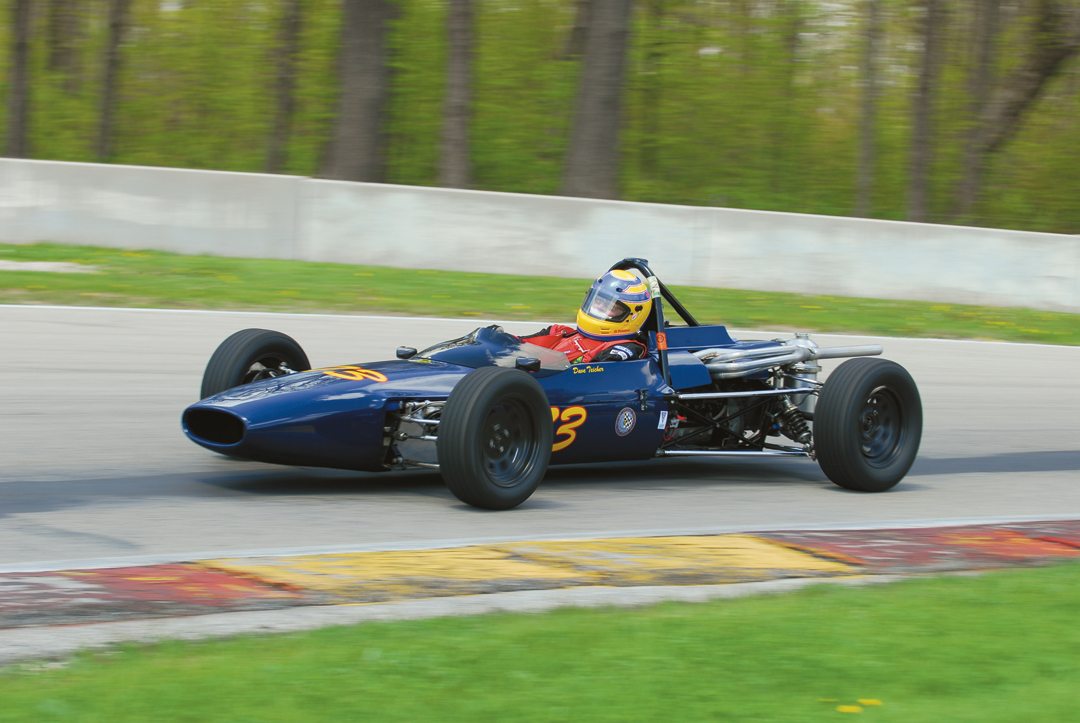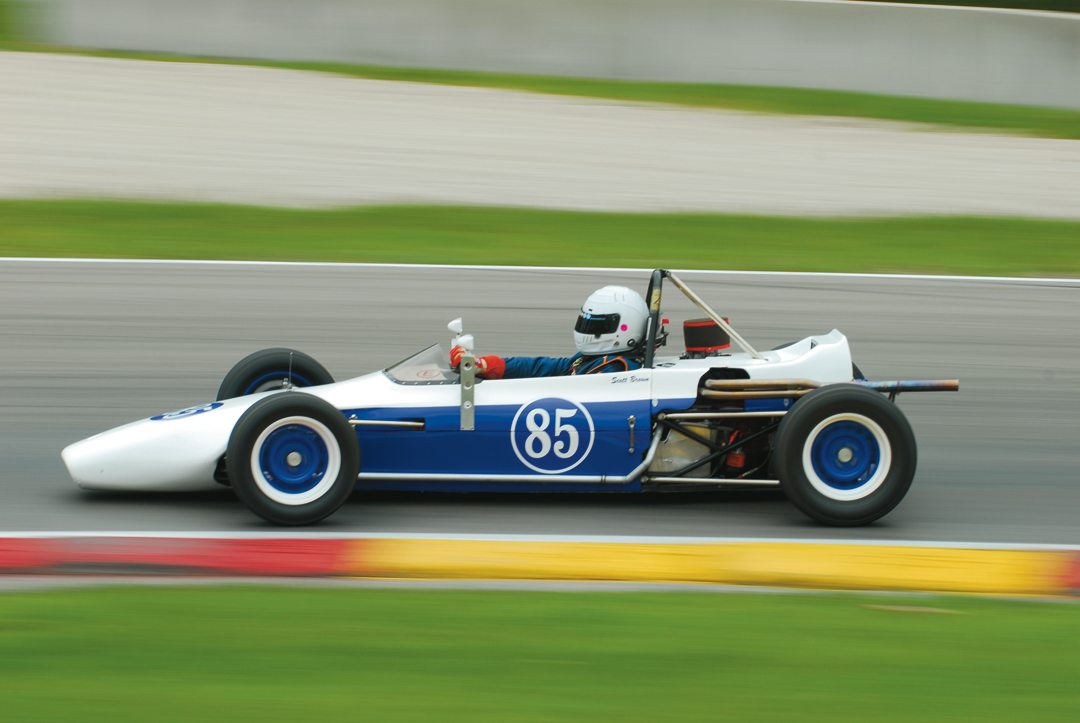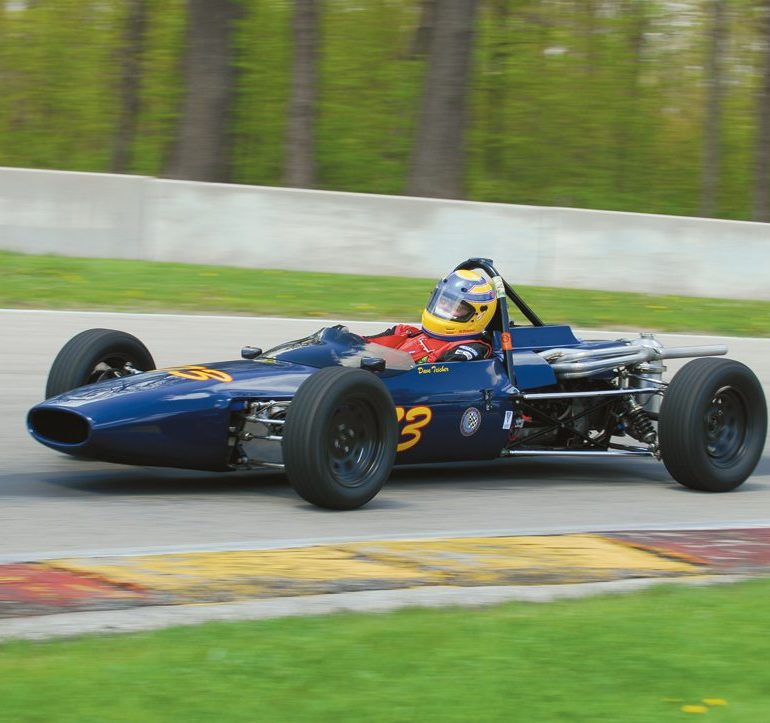Formula Ford was a specification racing series created on the idea that the best drivers would win if they were racing identical cars. The idea for this low-budget Formula was created by an Englishman named Geoffrey Clarke, who had a driver’s school called Motor Racing Stables based at the Brands Hatch Circuit. Clarke received support from Ford’s competition manager, Henry Taylor, and Ford’s director of public affairs, Walter Hayes. Ford supplied its 1600-cc Cortina GT engine—also known as the “Kent” engine—as well as its backing and name. Lotus Components built a car based on the Lotus 31 Formula Three car, calling it the Lotus 51 Formula Ford. Ironically, this early car had a Renault gearbox. They sold for the affordable price of just under £1,000, making racing in this series very affordable, since a Formula Three car of the day cost over £3,000. The Royal Automobile Club, Britain’s motorsports’ governing body, established a set of racing regulations. The first official race was held at Brands Hatch on July 2, 1967. From 1967 to the present, the Formula Ford series has produced some very exciting racing in many different makes of racing cars, as well as some great drivers and future champions, including Andretti, Fittipaldi, Schenken, Scheckter and Senna. Today, historic Formula Ford is an entry-level racing category and for the purposes of this guide, covers cars from 1967 to 1972. Keep in mind the greatest single factor in determining the value of a Formula Ford is the quality and cost of its preparation.
Make |
Model |
Acceptance |
Level III | Level II | Level I | Change | Notes |
| Alexis | 14 | 3 | $8,000 | $12,000 | $17,000 | ||
| 15 | 3 | $8,000 | $12,000 | $17,000 | |||
| 18, 18B | 3 | $9,000 | $14,000 | $18,000 | 3 | ||
| 22 | 3 | $9,000 | $14,000 | $19,000 | 3 | ||
| Beach | Mk II | 3 | $7,500 | $15,000 | $21,000 | 3 | |
| Bobsy | 3 | $5,000 | $10,000 | $15,000 | |||
| Caldwell | D9, D9B | 3 | $8,000 | $16,000 | $23,000 | ||
| Crossle | 16F | 3 | $9,000 | $13,000 | $17,000 | 3 | |
| 20F | 3 | $10,000 | $13,000 | $20,000 | 3 | ||
| Dulon | LD4, 4B, 4C | 3 | $5,000 | $10,000 | $15,000 | ||
| LD9 | 3 | $6,000 | $11,000 | $17,000 | |||
| Elden | PH6 | 3 | $5,000 | $11,000 | $17,000 | ||
| PH8 | 3 | $5,000 | $12,000 | $18,000 | |||
| PH10 | 3 | $6,000 | $13,000 | $20,000 | |||
| Elfin | 600 | 3 | $5,000 | $10,000 | $15,000 | 3 | |
| Forsgrini | Mk 12 | 3 | $5,000 | $10,000 | $15,000 | 3 | |
| Ginetta | G-18 | 3 | $7,000 | $12,000 | $17,500 | 3 | |
| Hawke | DL2, 2A, 2B | 3 | $7,500 | $11,000 | $19,000 | ||
| DL9, 9A | 3 | $10,000 | $12,000 | $21,500 | |||
| LeGrand | Mk 10 | 3 | $5,000 | $10,000 | $15,000 | ||
| Lola | T200 | 3 | $6,000 | $11,000 | $18,000 | ||
| T202 | 3 | $6,500 | $12,000 | $20,000 | |||
| T204 | 3 | $7,000 | $13,000 | $21,000 | |||
| Lotus | 51 A,B,C | 3 | $12,000 | $18,000 | $29,500 | ||
| 61M, MX | 3 | $9,000 | $15,000 | $20,000 | |||
| 69 | 3 | $19,000 | $26,500 | $37,000 | | 3 | |
| Macon | MR 7B | 3 | $4,000 | $9,000 | $14,000 | 3 | |
| MR8, 8B | 3 | $5,000 | $10,000 | $15,000 | 3 | ||
| March | 709, 719, 729 | 3 | $10,000 | $14,000 | $21,000 | ||
| McNamara | FFA | 3 | $4,000 | $9,000 | $15,000 | 3 | |
| Merlyn | Mk11, 11A | 3 | $12,000 | $17,000 | $25,000 | ||
| Merlyn | Mk17, 17A | 3 | $10,000 | $15,000 | $20,000 | ||
| Mk20, 20A | 3 | $12,000 | $17,000 | $22,000 | |||
| Mirage | Mk5 | 3 | $5,000 | $9,000 | $15,000 | 3 | |
| Mistrale | 3 | $5,000 | $9,000 | $15,000 | 3 | ||
| Nike | Mk 4, 6, 10 | 3 | $5,000 | $9,000 | $15,000 | 3 | |
| Royale | RP2 | 3 | $5,000 | $10,000 | $17,000 | ||
| RP3, 3A | 3 | $7,500 | $11,000 | $19,000 | |||
| Tecno | FF | 3 | $10,000 | $15,000 | $20,000 | 3 | |
| Titan | Mk 4, 5 | 3 | $10,000 | $15,000 | $20,000 | 3 | |
| Mk 6,6A,6B,6C | 3 | $10,000 | $15,000 | $24,000 | |||
| Winkelman | WDF1,2,3,4 | 3 | $10,000 | $15,000 | $20,000 |

1968 Russell Alexis 15
Alexis Cars Ltd. was founded in 1959 in Birmingham, England, by Englishman Alex Francis and Australian Bill Harris. Alexis had success in Formula Junior, Formula Two and Three, and built their first Formula Ford, the Type 14, in 1967. It was an evolution of their Mark 9 F3 car. The car had excellent handling, used the Hewland gearbox and was considered superior to the Lotus 51. The Alexis won more races in the first year (1967) of Formula Ford than any other make. Alan Taylor, who took over the helm of Alexis, did a deal with Jim Russell’s Driving School to create the Russell Alexis, or Type 14, which became the first Russell driving school car. By the end of the 1967 season, Colin Chapman himself enticed Russell into the Lotus camp. The type 15 was the evolution of the early Type 14—a magnificent early Ford.

1969 Caldwell D9
Ray Caldwell founded Autodynamics or A.D. in 1964 in Marblehead, Massachusetts. It was the largest American-built producer of single-seater racing cars, about 100 Formula Fords were built. With a patriotic ad campaign, Autodynamics sold the D9 to U.S. racers, notably one Skip Barber who won the 1969 SCCA Runoffs in the Caldwell’s first attempt. Other notable drivers were David Loring and Bill Alsup. The D9 was well built, very quick and had a very good engine supplier, Automotive Developments. Autodynamics went on to build cars through 1973 but sadly the energy crisis and other factors caused it to close its doors.
Criteria Used For Assessing Valuations for this Guide:
- Degree of Originality
- Overall Condition, Restoration
- Technology, Design, Coachbuilder
- Production Numbers/Rarity
- Competition History
- Ownership History, Documentation
- Modern Event Eligibility
Regional Variances
The prices stated in this guide are based on U.S. values. The values of historic racing cars can vary as much as 25%-35% in other countries, depending on local market appeal, currency rates, import duties, and VAT. Most of the time, we are able to document known sales or closed escrows, as they say in real estate. When this is not possible, a logical estimate of the car’s value is given, based on its sales history and relationship to cars of its type.
The prices stated in this guide are based on U.S. values. The values of historic racing cars can vary as much as 25%-35% in other countries, depending on local market appeal, currency rates, import duties, and VAT.
LEVEL |
VALUATION CATEGORIES |
|---|---|
I |
The best combination of all criteria. |
II |
Satisfies mid-range of criteria. |
III |
In need of restoration. Meets only a few points of criteria |




